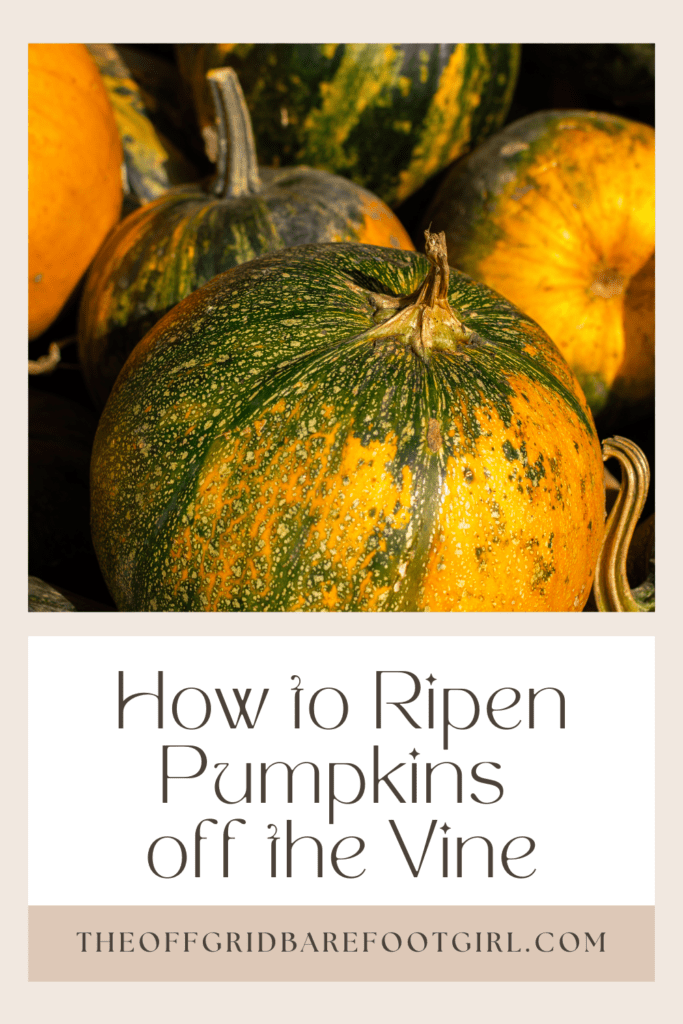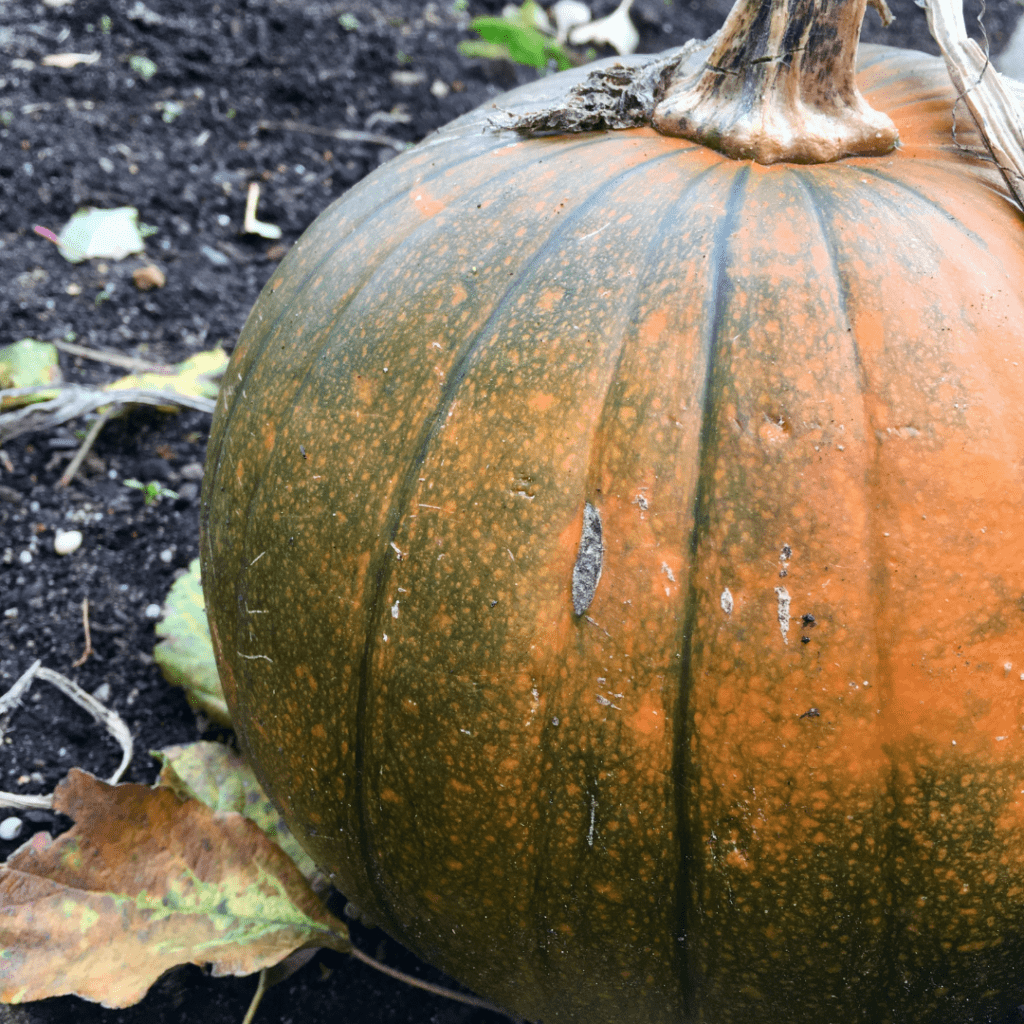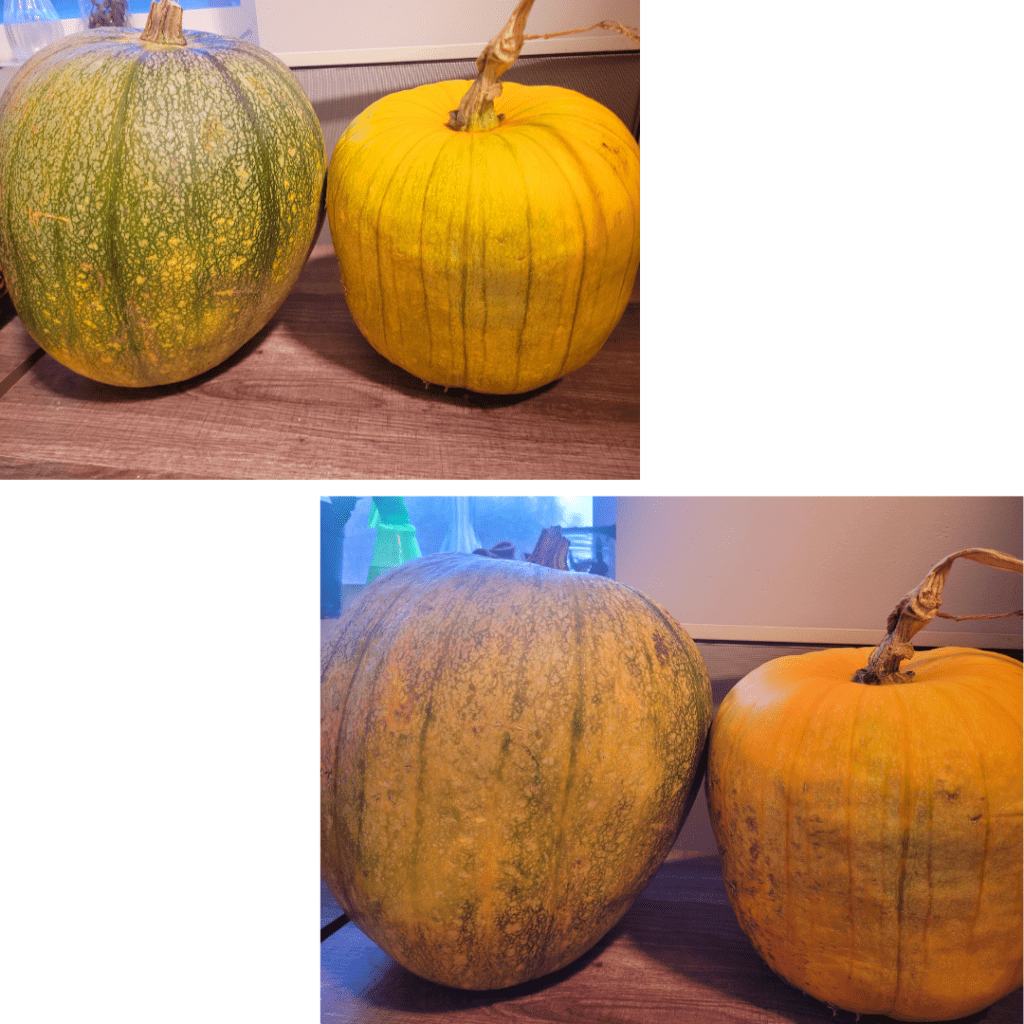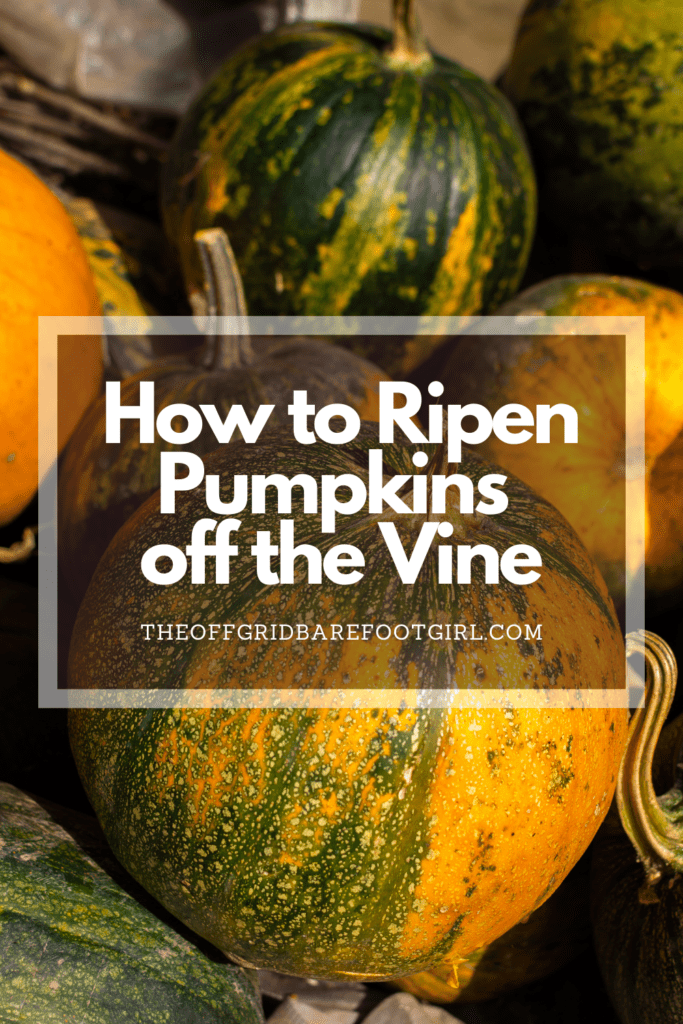Wondering how to ripen pumpkins off the vine? Whether frost is coming early or your pumpkins were picked too soon, you can still get them to turn that perfect deep orange. With the right techniques—like curing, sun exposure, and indoor ripening—you can enjoy fully mature pumpkins for décor, storage, or recipes.
If you’ve ever looked out at your pumpkin patch and realized the season’s first frost is coming before your pumpkins are ready, you know that sinking feeling. I’ve been there myself, and the good news is—you don’t have to give up on them. Pumpkins can actually finish ripening off the vine with just a little help. In this post, I’ll share the simple methods I use to turn green or pale pumpkins into vibrant orange beauties, perfect for carving, cooking, or storing through fall.
This is a pinnable post. Tap or hover over any image in this post to pin to your Pinterest Boards.

Introduction to Ripening Pumpkins off the Vine
So you’ve got a bunch of pumpkins growing in your backyard, but you’re not sure if they’re ready to be picked? Well, fear not, my pumpkin-loving friend! In this article, we’re going to dive into the art of ripening pumpkins off the vine. Sometimes, circumstances call for a little off-vine ripening magic, and I’m here to guide you through the process. So grab your gardening gloves and let’s get started!
Factors Affecting Pumpkin Ripening Process
When it comes to ripening pumpkins off the vine, there are a couple of factors that come into play. Let’s break them down, shall we?
Environmental Factors
Mother Nature loves to throw us curveballs, and she can definitely influence the ripening process of our precious pumpkins. Factors like temperature, humidity, and sunlight play a significant role. Pumpkins prefer a temperature range of 50-85°F (10-29°C) to ripen properly. So if you live in a cooler climate or it’s the wrong season for pumpkin ripening, you might need to step in and take matters into your own hands.
More than likely, you need to salvage your pumpkins at some point during the harvest period. Perhaps an unexpected frost arrives early and kills the vine that still has some unripe pumpkins growing. This has happened to me on more than one occasion!
Pumpkin Variety
Not all pumpkins are created equal when it comes to ripening off the vine. Some varieties are more predisposed to ripen faster while others take their sweet time. Keep in mind the specific variety you’re dealing with as it can affect the overall ripening process.
Identifying the Right Time to Harvest Pumpkins
Before we dive into the off-vine ripening groove, it’s essential to know when your pumpkins are ready for the big harvest. Let’s explore some telltale signs!
Visual Cues for Ripeness
Pumpkins are like the chameleons of the veggie world – they change color! When your pumpkins are ripe, their skin will take on a deep, consistent color. For example, if you’re dealing with orange pumpkins, they should be a vibrant, uniform orange all around. Say no to those green patches! Give ’em a gentle tap, too – if they sound hollow, you’re on the right track.
Stem Maturity Test
Another trick to determine if your pumpkins are ready for picking is by examining their stems. If the stems are hard and dry, it’s usually a good indication that they’re mature. On the other hand, if the stems are still green and tender, you might want to let them hang out a bit longer on the vine.
Preparing Pumpkins for Off-Vine Ripening

Now that you’ve successfully identified which pumpkins are ripe for the picking, it’s time to get them off the vine and into ripening mode. Let’s go through the necessary steps!
Harvesting Techniques
Gently cut the stem about 2-3 inches above the pumpkin. Be careful not to damage the pumpkin or leave too long of a stem, as it can lead to rot. Remember, we’re aiming for pumpkin-ripening perfection here!
Cleaning and Sanitizing
Once you’ve freed your pumpkins from the vine, give them a good wipe-down. Remove any dirt or debris they may have picked up from their vine adventures. It’s important to keep things clean and sanitary to avoid any unnecessary rot or spoilage during ripening.
Methods for Ripening Pumpkins Indoors
Ripening pumpkins off the vine might sound like some top-secret agricultural operation, but fear not, it’s actually quite simple. When the weather turns chilly and your pumpkins are still looking a little green, it’s time to bring them indoors. Here are a couple of methods you can use to help those pumpkins reach their full orange potential:
Storing Pumpkins In a Dry, Warm Location
Find a cozy spot in your home where the pumpkins can hibernate in peace. Make sure it’s dry and warm, with a temperature around 70-80°F (21-27°C). Avoid any areas with extreme temperature fluctuations, like next to the radiator or above the dishwasher. Your pumpkins deserve better than that!
Utilizing Ripening Chambers
If you want to take your pumpkin ripening game to the next level, consider creating a ripening chamber. It’s like a luxury resort for your pumpkins, minus the poolside cocktails. Place your pumpkins in a well-ventilated room and cover them with a light cloth or paper bag. This helps trap the natural ethylene gas produced by the pumpkins, which speeds up the ripening process.
Caring for Ripening Pumpkins During the Process

Ripening pumpkins might seem like a “set it and forget it” kind of deal, but they still need a little love and attention. Here are a couple of tips to ensure your pumpkins are pampered during their color transformation:
Monitoring Temperature and Humidity
Check in on your pumpkins every now and then to make sure they’re not feeling too hot or too humid. Aim for a Goldilocks scenario, with temperatures around 70-80°F (21-27°C) and humidity levels kept at a comfortable 50-70%. It’s the pumpkin equivalent of a cozy sweater and a hot cup of cocoa.
Rotating and Inspecting Pumpkins
Just like us, pumpkins need a bit of exercise to keep them in tip-top shape. Give your pumpkins a gentle rotation every week or so to make sure they ripen evenly. While you’re at it, take a moment to inspect them for any signs of trouble like soft spots, blemishes, or mysterious crop circles.
Troubleshooting Common Issues In Pumpkin Ripening
When it comes to ripening pumpkins, sometimes things don’t go according to plan. Don’t worry, I’ve got your back. Here are a couple of common issues you might encounter and how to tackle them:
Mold and Fungal Growth
If you notice any mold or fungal growth on your pumpkins, act fast! Remove the affected areas immediately and gently clean the remaining pumpkin with a mixture of water and mild soap. Make sure to dry it thoroughly afterward, so your pumpkin doesn’t turn into the set of a spooky horror movie.
Premature Rotting
Oh no, a case of premature rotting! This can happen if the pumpkins are damaged in any way or if they are exposed to excessive moisture. To prevent further rotting, trim away the affected parts and let the pumpkin dry out for a bit. It might not be the picture-perfect pumpkin you envisioned, but it can still make a mean pumpkin pie!
Harvesting and Utilizing Ripe Pumpkins
Congratulations, your pumpkins have reached peak ripeness! Now it’s time to reap the delicious rewards. Here are a couple of tips for harvesting and making the most of your ripe pumpkins:
Harvesting Techniques for Ripe Pumpkins
To harvest your ripe pumpkins, gently cut the stem with a sharp knife, leaving a couple of inches attached to the pumpkin. Be careful not to damage the skin, as any wounds can lead to potential rot. Now you can proudly display your bountiful harvest or start planning all the pumpkin-themed recipes you’ll conquer!
Recipe Ideas and Preserving Pumpkin Harvest
Speaking of pumpkin recipes, the possibilities are endless! From classic pumpkin pie to savory pumpkin soups and even pumpkin spice latte (yes, I went there), your imagination is the limit. If you can’t use all your ripe pumpkins right away, don’t fret. You can preserve them by pureeing, freezing, or even canning. That way, you can savor the taste of fall all year round.
So, go forth and ripen those pumpkins off the vine like the pumpkin-whispering pro you are. Just remember to give them some TLC, watch out for any unexpected mold, and get ready to enjoy the fruit of your pumpkin-ripening labor.
Conclusion
By following the techniques and tips outlined in this article, you can successfully ripen pumpkins off the vine and maximize your harvest. Remember to consider environmental factors, properly identify the right time to harvest, and employ appropriate methods for off-vine ripening. With careful monitoring and attention, you can enjoy fully ripened pumpkins that are ready for various culinary uses or festive decorations. So, don’t let unripe pumpkins go to waste – take control of the ripening process and savor the rewards of your efforts.

Frequently Asked Questions
1. Can all pumpkins be ripened off the vine?
Not all pumpkins are suitable for off-vine ripening. Some varieties, especially those with thick rinds, may not ripen fully or may rot before reaching maturity. It’s important to choose pumpkin varieties known for their potential to ripen off the vine successfully.
2. How do I know if a pumpkin is ripe enough for off-vine ripening?
There are several indicators of pumpkin ripeness. Look for a deep, consistent color, such as a fully orange or deep yellow skin, depending on the variety. The stem should also be dry and corky. Additionally, the pumpkin should feel firm and have a hard rind when gently pressed.
3. Can I use artificial methods to speed up the pumpkin ripening process?
While it is possible to use artificial methods such as ethylene gas or accelerated ripening chambers to speed up the ripening process, it is not recommended. Artificial methods can sometimes result in poor quality or premature rotting of the pumpkins. It is best to allow pumpkins to ripen naturally or use gentle, controlled methods to encourage ripening.
4. How long does it take for pumpkins to ripen off the vine?
The ripening time for pumpkins off the vine can vary depending on various factors such as pumpkin variety, temperature, and humidity. Usually, pumpkins take anywhere from one to four weeks to ripen off the vine. Regular monitoring and observation will help determine the readiness of the pumpkins for harvesting.
Summary
I hope I have inspired you to plant your garden with these tips and products.
If you were encouraged by this post, I invite you to check out my FREE Printables Page for fun free printables, planners, and charts.
ENTER MY FREE Printables Page HERE
Here are some more of my gardening inspiration posts to check out!
How to Grow Your Own Food Without a Backyard!
My Best Spring Garden Posts in One Spot!
Spring Garden Soil Prep: How to Improve Your Soil
Seed Starting Mix 101: Everything You Need to Know!
How to Plan a 200 Sq. Ft. Vegetable Garden Layout
How I Easily Start My Seeds Without Expensive Grow Lights!
How to Create a Smart Garden: Tech Meets Nature!
The Best Cheap Raised Vegetable Garden Beds
How to Grow Artichokes: Plant Once and Harvest for 5 Years!
The Best 8 Fast-Growing Vegetables In Just 45 Days!
From Snow to Sow: Plan Your Spring Garden Now!
11 Fun Ways to Brighten Your Spring Garden with Personality
Top 10 Spring Garden Crops to Harvest in 30 Days and Eat Now!
The Best Survival Crops for Caloric Survival
My Victory Garden: What I Learned from 5+ Years
Why Every Family Should Have a Victory Garden in Their Backyard Now!
The Best Perennials for a Long-Term Survival Garden
The Best Essential Oils for Plants That Repel Garden Bugs
More Gardening Projects!
How to Grow Green Garden Peas: Perfect Plump Peas!
Hugelkultur: Does This Epic Pioneering Method Actually Work?
9 Ways to Celebrate Earthing Day in Your Garden!
Gardening Indoors: Secrets of Growing Your Food Inside!
How to DIY a Milk Jug Drip Irrigation System!
Why Cedar Mulch Is The Perfect Natural Weed Barrier
Gardening Projects
Onions: How to Grow Onions for Storage
Peas: How to Grow Garden Peas for a Bumper Crop
Carrots: How to Grow Carrots for a Bountiful Harvest
Prep Your Garden for Spring Planting with These Expert Tips!
How to Grow a Prepper Garden to Survive and Thrive
The Best Garden Tools You Need for a Productive Season
Fastest Growing Vegetables for Your Survival Garden
How to Grow Marigolds As Pest Control In Your Vegetable Garden
Must-Have Tools for a Successful Balcony Vegetable Garden
How to Effectively Combat Powdery Mildew in Your Garden
The Best Tips for Organic Gardening
How to Release Ladybugs In Your Garden for Organic Pest Control
The Best Garden Snail Control Strategies
The Best Spring Vegetables to Grow in Your Garden
Seed Starter Mix: How To Make Your Organic Seed Starter Mix At Home
How to Grow a Productive Canning Garden
How to Plant and Grow a Salsa Garden
Easiest Heirloom Vegetable Seeds to Grow Now
How to Use the Hand Twist Claw Tiller: Tackling Tough Soil
More Fun Gardening Posts to Check Out!
Planning Your Garden: How to Plan a Vegetable Garden: Expert Green Thumb Tips!
Winterizing the Garden: How to Winterize Your Vegetable Garden: Step-by-Step Checklist
Mulching the Garden: How to Make Leaf Litter Mulch
Grow a Pumpkin Patch: How to Grow a Pumpkin Patch in Your Backyard
How to Grow a Fall Garden: 9 Best Fall Crops
Clever Ways to Incorporate Indoor Composting into Your Home
How to Start Composting for the Garden: A Step-by-Step Guide
The Ultimate Guide to Composting in Your Suburban Backyard
Why I Built A Survival Garden in My Backyard
16 Best Medicinal Herbs to Grow in Your Garden Now
Blessings,
The Off Grid Barefoot Girl





